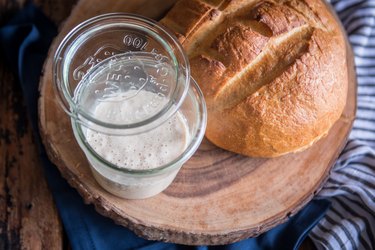
It took me years to work up the courage to begin a sourdough starter—it just seemed so hard. Now that I've discovered how easy it is (and how many recipes you can make with it), I encourage everyone to give it a go! It takes about a week, but your active time is only about 5 minutes a day. I now have an entire Pinterest board dedicated to all the things I can make with it: pizza dough, waffles, doughnuts, Dutch oven loaves, and more!
Video of the Day
Things You'll Need
1 cup whole wheat flour
5–7 cups all-purpose flour
Bottled water
Storage jar with breathable lid (not airtight)
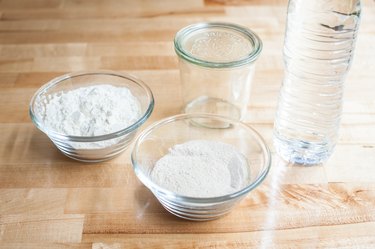
1. Add the ingredients to a jar
On day 1, add 1 cup whole wheat flour (you can also use rye flour) and 1/2 cup bottled water to a clean storage jar with a lid that isn't airtight. Stir to combine and then store at room temperature.
Tip
Bottled water is what you need! The contaminants in tap water, like chlorine, can inhibit the yeast's ability to grow and can kill your starter.
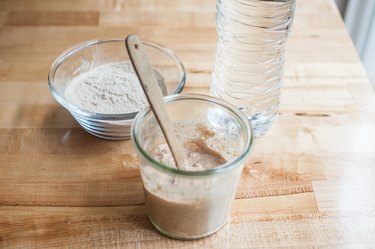
2. Remove half of the starter and feed the rest
On day 2, remove about half of the starter (i.e., 4 ounces should be removed, and 4 ounces should be left). Feed the remaining starter 1 cup all-purpose flour and 1/2 cup bottled water. Stir and then place the lid back on the jar and store at room temperature.
Hey! Why did we switch flours?
Whole wheat flour has more of the good bacteria and yeast that you're looking for, so that's why we started with it. Once the starter is active, most people prefer the flavors of a starter with all-purpose flour. If you want a whole wheat starter, feel free to continue with that type of flour.
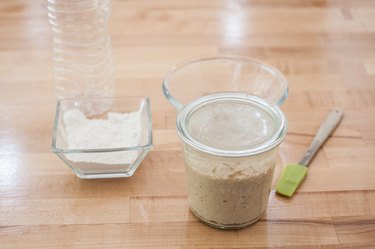
3. Feed the starter again
On day 3, you may or may not see less activity than the previous day, and that's OK! Just feed it as you did the previous day and store it at room temperature.
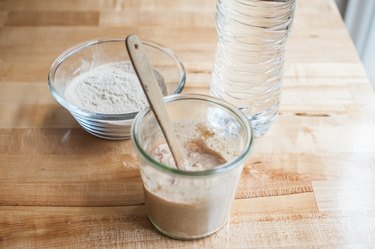
4. Continue the feeding process
On days 4 through 7, continue to pour out half, feed with 1 cup all-purpose flour and 1/2 cup bottled water, stir, and store at room temperature. Do this once a day until the starter is ready.

5. Test the starter
To determine whether your starter is ready, you want to look for two things: bubbles and volume. If there are a lot of bubbles and the starter is larger than it was the day before, it's probably ready. To test it, drop a small amount into a bowl of water. If it floats, it's ready to go!
Tip
To see how much the starter has grown, wrap a rubber band or piece of colored tape around the jar.
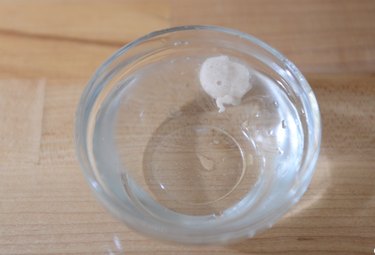
6. Use the starter
Once the starter is ready, you can use the amount you remove during a regular feeding as the base for your recipe. Discard it (or give it to a friend to use as their own starter) if you don't plan to bake. If you use it regularly, store it at room temperature and feed it daily.
If you don't use it regularly, just store it in the fridge after a feeding for up to a week. Remove it from the fridge and feed it weekly. When you want to use it, wake it up by feeding it and leaving it at room temperature for about 36 hours before baking.
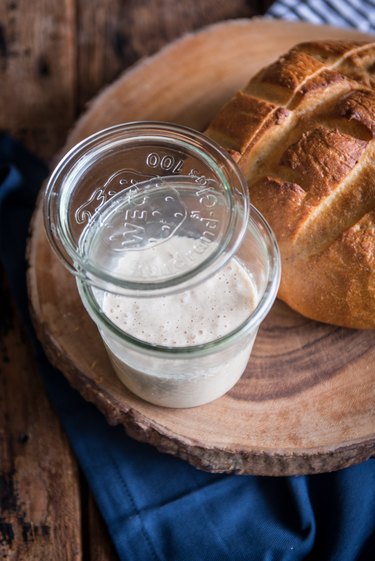
Common Questions
How long can you use a sourdough starter?
As long as you regularly feed your sourdough starter (or keep it refrigerated and feed it weekly), you can continue to use it indefinitely.
What happens if you forget to feed the starter?
It's usually OK if you forget a feeding or if you accidentally feed your starter too little or too much. If you see a bit of brown, black, or gray color on top, don't worry —
just pour it off and continue with the regular feedings. But if you see streaks or patches that are orange or pink in color or any signs of mold, your starter has gone bad, and it should be discarded.
What can you make with a sourdough starter?
In addition to delicious bread, you can make pancakes, waffles, pizza dough, doughnuts, biscuits, crackers, and just about any baked good!